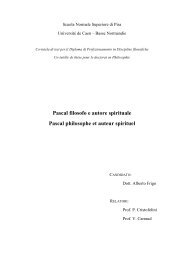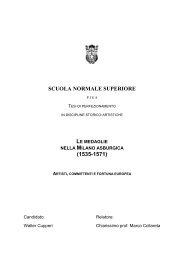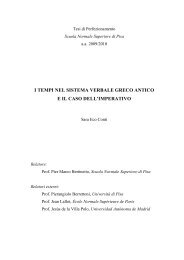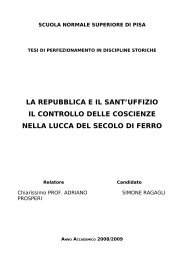CATULLUS 68 - Scuola Normale Superiore
CATULLUS 68 - Scuola Normale Superiore
CATULLUS 68 - Scuola Normale Superiore
Create successful ePaper yourself
Turn your PDF publications into a flip-book with our unique Google optimized e-Paper software.
When I started working on this volume, I wanted to assemble a variorum edition, in which the views of all<br />
scholars of note on every problem would be quoted. This project soon turned out to be impracticable: since<br />
the editio princeps of 1472 there have appeared many scores of editions of Catullus, dozens of<br />
commentaries, and prodigious amounts of scholarly studies; those on Catullus <strong>68</strong> alone fill many thousands<br />
of pages. I have had to skip and to omit; in compensation, I have tried to make the bibliography as complete<br />
as possible.<br />
The following pages will show only up to a point how much I owe to earlier Catullan scholarship, in<br />
particular to earlier commentaries. One source of inspiration were the great Renaissance triad of Muretus,<br />
Statius and Scaliger. Among more recent commentators Ellis and Kroll excel in erudition, Thomson in<br />
familiarity with the primary manuscripts, and Fordyce in lucidity and common sense. Finally, I should<br />
mention the work that this volume hopes to supplant. There has only appeared one commentary on Catulus<br />
<strong>68</strong> so far, a thin book published in 1788 by the Dutch scholar Laurentius Santenius in preparation for a<br />
commentary on all of Catullus that he never wrote. He is not well known today, but his commentary on<br />
Catullus <strong>68</strong> is an excellent achievement: where necessary, he listed the readings of an impressive number of<br />
manuscripts (he appears to have come quite close to discovering O, almost eighty years before it caught the<br />
eye of Ellis) and displayed laudable judgement in commenting on the text.<br />
*****<br />
It was my supervisor, Gian Biagio Conte who set me working on this topic; I would like to thank him for<br />
having made this match and for having supported me throughout this project. I owe much of what I know<br />
about textual criticism to his seminars. Philip Hardie, Stephen J. Harrison, Arnd Kerkhecker, John D.<br />
Morgan and Ernst A. Schmidt read parts of this dissertation in various stages of completion and made helpful<br />
comments, as have Glenn W. Most and participants of his research seminar at the <strong>Scuola</strong> <strong>Normale</strong>. In the<br />
autumn of 2007 James J. O’Hara invited me to present part of the thesis as a talk at the Department of<br />
Classics at the University of North Carolina; he and his colleagues and students proved a responsible and<br />
congenial public, and I have benefited much from their comments. In Pisa my friends Gianfranco Adornato<br />
and Federico Biddau advised me on questions of iconography and spelling, respectively; Gianfranco also<br />
procured a picture of a capsa. Christian Kaesser, Jürgen Leonhardt, R.G.M. Nisbet, John M. Trappes-Lomax<br />
and Michael D. Reeve advised me on various matters, David S. McKie allowed me to use his excellent<br />
doctoral dissertation, while D.F.S. Thomson helped me to track down the Hale-Ullman Papers. Part of the<br />
proofs were read with characteristic acumen by my grandfather, Kálmán Ruttkay, who brought an outsider’s<br />
eye to Latin scholarship and made many helpful criticisms.<br />
I did the bulk of the work in the well-stocked library of the <strong>Scuola</strong> <strong>Normale</strong> <strong>Superiore</strong>, first as a visiting<br />
scholar and then as a perfezionando. At a time of economic difficulties for the Republic of Italy I was given<br />
7






